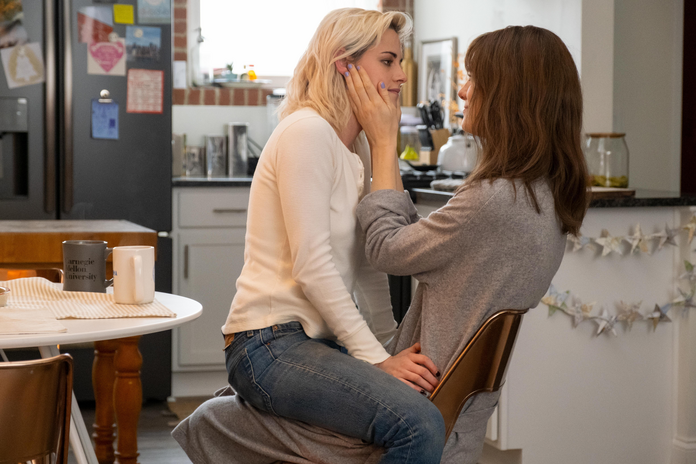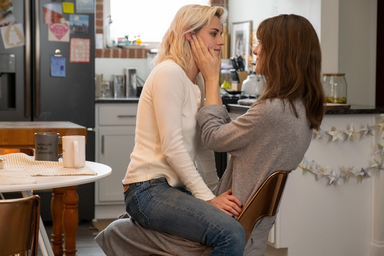When we look at the hype surrounding Clea Duvall’s The Happiest Season, which aired on Hulu in late November of 2020, it remains obvious that the attention surrounding the film, whether positive or negative, was in large part because it finally depicts two queer women at the forefront of a holiday rom-com. It can be argued that the excitement about a story like this, regardless of its level of cheesiness, proves that there is a lack of stories that allow queer women to see feel-good stories about people who resemble themselves. This only adds to the narrative that the entertainment industry and society at large has pushed on queer women which suggests that in terms of feeling seen by the media, they need to take what they can get and be happy with it. So, what about when queer women are included in these stories but they are only seen as villains, walking offensive stereotypes, sheer points of comedic relief, or are killed off in some violent manner? Have we truly reached a point where we need to be happy with that because at least our community has finally received some screen time? Ultimately, are we doing enough for representation of queer women in film and television?
Research has proven that while progress has been made, there is still not enough accurate, realistic and positive representation of queer women in television shows: not enough to allow queer women to feel included in this kind of media, and not enough to achieve anything close to equality for the queer community at large. For queer women specifically, though, this issue just adds to the marginalization that all women face. All too often, when queer women do see characters who relate to their sexuality, it is in a way where stereotypes are present, blatant and offensive, furthering the stigma that already surrounds this community. And so, to use the performing arts to fight against systems of hegemony and patriarchy and promote equal representation through hugely powerful mediums, we need more truthful, positive, and common representation for queer women: it must become common practice to create and promote shows that accomplish this.
There are plenty of stereotypes present in the arts, but for straight men and women, there are just as many if not more accurate depictions of their lives and personalities which evens the playing field. This is not the case for queer women. The stereotypes are overabundant, overwhelming and unfair. In Richard Dyer’s “The Role of Stereotypes,” he quotes author T.E Perkins: “to refer ‘correctly’ to someone as a ‘dumb blonde’, and to understand what is meant by that, implies a great deal more than hair colour and intelligence. It refers immediately to her sex, which refers to her status in society, her relationship to men, her inability to behave or think rationally, and so on. In short, it implies knowledge of a complex social structure.” Similarly, the many wounding labels attached to queer women are much more deeply impactful than what they are on the surface. In addition to being derogatory in nature, they also have implications about the inferiority, unworthiness and overall ranking in our societal structure of all women who identify as anything other than straight. And, as research has shown, in this community specifically, stereotypes and the shortcuts they create in people’s minds about queer women has led to a great deal of discrimination and violence toward them.
Orange is the New Black is chock-full of women loving women, but when looking more closely at the characters, their personal makeup and the way they are portrayed, it becomes clear through characters like Nicky and Boo who are often villainous and manipulative, Piper and Alex who have a toxic and often abusive relationship, and Poussey who is brutally killed, that lesbian and especially incarcerated lesbian tropes are ever present. The same holds true for The L Word, which much research has proven caters to the male gaze and hyper-sexualizes the queer female characters and often depicts their sexuality as the only interesting part of their story. And while there is plenty to critique about the way queer women are presented in both of these shows, both are still often viewed as a “win” for the queer community solely because they contain queer female characters, and this is something that is still so rare the grand scheme of the industry. In fact, according to GLAAD, gay men comprise 83 percent of LGBT representation in the media, while lesbian characters are about 35 percent. What does the mere existence of shows like OITNB and The L Word achieve, though, if they further the stereotypes and negative portrayals of and exploiting queer women and their romantic relationships?
On The Walking Dead, Tara was a character who was proudly lesbian, but this was treated as a non-issue, which certainly helped to represent the character in a more positive light. However, she was also given minimal storylines and screen time compared to the straight and male characters on the show, lost her only love interest in five seasons to a violent murder, and was recently among the characters who were killed and had their heads placed on a spike in a season finale. These are just a few of the many examples of improper and limited representation of queer women on television. Following Tara’s death, the show still includes three queer female characters, one of which is Black and hard-of-hearing, and another who is Asian and English. So, it appears that this show is making progress in terms of representing queer women as strong fighters and people who are more than their sexual endeavors, diversifying their cultures and abilities, amping up their screen time and (thus far) keeping them alive.
When Atypical returns for season 4, it will be bittersweet as this next season will be the series’ last. But thankfully we live in a world of streaming, so this one we can look back on for as long as it remains on Netflix in order to take note of the nonharmful manner in which the show’s queer women are potrayed. Casey and Izzie are normal teenagers who started as frenemies, became close friends and eventually fell for one another. As Casey grapples with her feelings for Izzie (which grow as Casey remains in a relationship with her boyfriend, Evan), the issue is not about being in a relationship with another girl. Her family and friends and even Evan treat that as a non-issue. Rather, it is a universal dilemma of loving two people at once – any two people – regardless of their gender. But the best part about this show and characters like Casey and Izzie is also a bit of a disappointment: it is one of very few accurate, non-stereotypical, normalized representation of young queer women. Bridgette-Lundy Paine, the actor behind Casey, agrees. In an interview with Advoctae, they said “I’m just like constantly stunned at how hetero stories — even stories that claim not to be [hetero] — continue to be. I hope that we can create a pushback against that.”
This issue plays into a system that affects the world on an even larger scale than that of film and television: the patriarchy. The insistence of a patriarchal society that males are inherently superior to females seeps into all aspects of our daily lives, including the media we consume. Both straight and gay males are given far more and quality representation than women in the film and television sphere. There are more gay male characters, there are more of these characters who do not play into gay stereotypes, less of these characters are killed off of their respective shows or movies, and stories about men loving men are given more critical claim and artistic accolades than those of queer women. An example of this that happened a few years back is Poussey Washington’s death. Poussey, a Black, lesbian woman, had her airway crushed by a white man who knelt on her neck as she begged him to get off because she could not breathe before she finally died, her body being left on the floor of the prison cafeteria. This relates directly to the idea that in addition to heteronormative superiority, patriarchal ideals are also involved in queer representation since even within the large marginalized group of queer people, men still receive representation that is imperfect, but better than women nonetheless. Also, queer women are constantly being sexualized and used to attract male viewers who can enjoy some girl-on-girl. According to the patriarchy, this is fine, because as long as the guys are being kept happy, that is enough.
The short answer to the question posed at the beginning of this piece, is “no.” There are too few creators being given a large platform and a wide audience range who are actually prioritizing queer female representation that is helpful more than it is harmful. We cannot rely and put all of the onus on the same few people who do provide quality representation and expect to eradicate this issue without more content creators collectively putting in the work to make sure queer women everywhere can feel truly seen in the stories being told. Poor representation is detrimental not only to visual storytelling mediums such as film and television, but to society and its future. It is also vital that queer women play a part in the process of developing stories about and including people like themselves whether this mean directing, supervising, being in the writer’s room, or holding any other decision-making position. When looking at society outside of a heteronormative and patriarchal structure, queer women are no less worthy of equitable and truthful representation in widely-disseminated media than any other community. Thus, while we cannot make up for years of exclusion, homophobic and blatantly anti-female films and shows, we must take the proper steps to make as many reparations and as much headway as humanly possible in the pursuit of righting this wrong.


